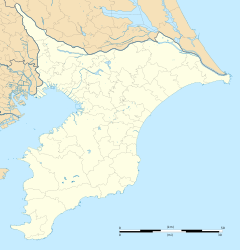Matsudo Station
JJ06 JL22 SL01 Matsudo Station 松戸駅 | ||||||||||||||||||||||||||||||||||
|---|---|---|---|---|---|---|---|---|---|---|---|---|---|---|---|---|---|---|---|---|---|---|---|---|---|---|---|---|---|---|---|---|---|---|
 West Exit, Matsudo Station | ||||||||||||||||||||||||||||||||||
| General information | ||||||||||||||||||||||||||||||||||
| Location | 1181 Matsudo, Matsudo-shi, Chiba-ken 271-0092 Japan | |||||||||||||||||||||||||||||||||
| Coordinates | 35°47′03″N 139°54′03″E / 35.7843°N 139.9007°E | |||||||||||||||||||||||||||||||||
| Operated by | ||||||||||||||||||||||||||||||||||
| Line(s) |
| |||||||||||||||||||||||||||||||||
| Distance | 15.7 km (9.8 mi) from Nippori | |||||||||||||||||||||||||||||||||
| Platforms | 4 island platforms | |||||||||||||||||||||||||||||||||
| Other information | ||||||||||||||||||||||||||||||||||
| Status | Staffed (Midori no Madoguchi ) | |||||||||||||||||||||||||||||||||
| Station code | ○SL01 (Shin-Keisei) | |||||||||||||||||||||||||||||||||
| Website | www | |||||||||||||||||||||||||||||||||
| History | ||||||||||||||||||||||||||||||||||
| Opened | 25 December 1896 | |||||||||||||||||||||||||||||||||
| Passengers | ||||||||||||||||||||||||||||||||||
| FY2019 | 100,062 daily (JR), 105,704 (Shin Keisei) | |||||||||||||||||||||||||||||||||
| Services | ||||||||||||||||||||||||||||||||||
| ||||||||||||||||||||||||||||||||||
| ||||||||||||||||||||||||||||||||||
Matsudo Station (松戸駅, Matsudo-eki) is an interchange railway station in the city of Matsudo, Chiba, Japan, operated by East Japan Railway Company (JR East) and the private railway company Shin-Keisei Electric Railway.
Lines
[edit]Matsudo Station is served by the Jōban Line and is 15.7 km from the terminus of the line at Nippori Station in Tokyo. It is also the terminus for the Shin-Keisei Line and is 26.5 kilometers from the opposing terminus at Keisei Tsudanuma Station.
Station layout
[edit]The station consists of four island platforms serving eight tracks. The JR portion of the station has a Midori no Madoguchi staffed ticket office.
Platforms
[edit]| 1-2 | JJ Jōban Line (Rapid) | for Kashiwa, Toride, Narita, Tsuchiura, Ishioka and Mito |
| 2-3 | JJ Jōban Line (Rapid) | for Kita-Senju, Nippori, Ueno JU Ueno-Tokyo Line for Tokyo and Shinagawa |
| 4-5 | JL Jōban Line (Local) | for Shim-Matsudo, Abiko, and Toride |
| 5-6 | JL Jōban Line (Local) | for Ayase C Tokyo Metro Chiyoda Line for Kita-senju and Yoyogi-uehara |
| 7-8 | SL Shin-Keisei Line | for Yabashira, Shin-Kamagaya, Kita-Narashino, Shin-Tsudanuma, and Keisei-Tsudanuma KS Keisei Chiba Line for Keisei Makuharihongō, Keisei Chiba, and Chiba-Chūō |
History
[edit]Matsudo Station opened on December 25, 1896[1] as a station on the Nippon Railway Tsuchiura Line. It was nationalised on November 1, 1906, becoming part of the Japanese Government Railways (JGR) and the line name changed on October 12, 1909 to the Jōban Line. JGR became Japanese National Railways (JNR) after World War II. The Shin-Keisei Line began operations from April 21, 1955. The station was absorbed into the JR East network upon the privatization of JNR on April 1, 1987.
Future plans
[edit]Effective April 2025, the Shin-Keisei platforms are to be absorbed by the Keisei Electric Railway as the result of a buyout.[2][3]
Passenger statistics
[edit]In the 2015 data available from Japan’s Ministry of Land, Infrastructure, Transport and Tourism, Matsudo → Kita Senju of the Joban (Rapid) line was one of the train segments among Tokyo's most crowded train lines during rush hour.[4]
In fiscal 2019, the JR East station was used by an average of 100,062 passengers daily (boarding passengers only), making it the 39th-busiest station operated by JR East.[5] In fiscal 2019, the Shin-Keisei Electric Railway station was used by an average of 105,704 passengers daily (boarding passengers only), making it the busiest station operated by the company.[6] The daily passenger figures (boarding passengers only) for the JR East station in previous years are as shown below.
| Fiscal year | Daily average |
|---|---|
| 2000 | 104,051[7] |
| 2005 | 101,602[8] |
| 2010 | 99,468[9] |
| 2015 | 100,079[10] |
Surrounding area
[edit]- Seitoku University
- Tojogaoka Historic Park
- Matsudo City Hall
See also
[edit]References
[edit]- ^ 松戸駅情報 [Matsudo Station information] (in Japanese). Japan: East Japan Railway Company. Retrieved 15 September 2014.
- ^ "京成電鉄、新京成電鉄を吸収合併へ2025年4月 現在の路線・駅は維持する方針" [Keisei Electric Railway will absorb the Shin-Keisei Electric Railway in April 2025; Plans made to maintain current routes and stations]. Chiba Nippo (in Japanese). 31 October 2023. Archived from the original on 31 October 2023. Retrieved 31 October 2023.
- ^ "新京成電鉄、解散・消滅へ - 京成電鉄が吸収合併、2025年実施予定" [Shin-Keisei Electric Railway to dissolve and disappear - Keisei Electric Railway will absorb the railway in the merger, scheduled to take place in 2025]. MyNavi Corporation (in Japanese). 31 October 2023. Archived from the original on 31 October 2023. Retrieved 31 October 2023.
- ^ "Most Crowded Rush Hour Train Lines in Tokyo". Blog. 2017-05-04. Retrieved 2024-08-11.
- ^ 各駅の乗車人員 (2019年度) [Station passenger figures (Fiscal 2019)] (in Japanese). Japan: East Japan Railway Company. 2020. Retrieved 11 August 2020.
- ^ 千葉県統計年鑑(平成24年) 千葉県統計年鑑(平成24年)] (in Japanese). Shin Keisei Electric. Retrieved 15 December 2020.
- ^ 各駅の乗車人員 (2000年度) [Station passenger figures (Fiscal 2000)] (in Japanese). Japan: East Japan Railway Company. Archived from the original on 9 October 2014. Retrieved 15 September 2014.
- ^ 各駅の乗車人員 (2005年度) [Station passenger figures (Fiscal 2005)] (in Japanese). Japan: East Japan Railway Company. Archived from the original on 9 October 2014. Retrieved 15 September 2014.
- ^ 各駅の乗車人員 (2010年度) [Station passenger figures (Fiscal 2010)] (in Japanese). Japan: East Japan Railway Company. Archived from the original on 6 October 2014. Retrieved 15 September 2014.
- ^ 各駅の乗車人員 (2019年度) [Station passenger figures (Fiscal 2015)] (in Japanese). Japan: East Japan Railway Company. Retrieved 15 September 2020.
External links
[edit]- JR East Station information (in Japanese)
- Shin Keisei Station Information (in Japanese)


